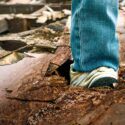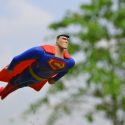According to the World Health Organization, every day, 3,700 people worldwide die from car accidents. More than half of them are pedestrians, cyclists, or motorcyclists. That’s more than 640,000 people, who are not in cars, who are killed on the road every year.
Up to 93% of these accidents happen in developing countries. But it’s not only there. In the U.S., the National Center for Health Statistics estimated that 7,680 pedestrians were killed by cars in 2018, and that was the highest number in 30 years. Almost every hour, a person died in the U.S. from traffic accidents. But will you become one of them?
What time of day are you most likely to be hit? How should you position your body? Can you reduce the strength of the impact?
STEP 1: Make eye contact
As a pedestrian, on a road, you’re at the bottom of the food chain. You’re 150% more likely to die in a traffic accident than passengers in a car. So, never fool around. Even when you use the crosswalks during the green pedestrian crossing light, make sure that drivers notice you. And be especially careful with bigger cars, since they’re twice as likely to kill you than smaller cars.
A study conducted by the Insurance Institute for Highway Safety found that when cars travelled at 64 km/h (40 mph) or more, and it hit pedestrians, they had a 54% chance of dying. But when an SUV travelled at the same speed, all the pedestrians were killed. So, don’t fool around, and make eye contact with drivers, so they know you’re there.
STEP 2: Plan your strolls
Yup, you might be in the wrong place at the wrong time. But you can also avoid that. According to the U.S. National Highway Traffic Safety Administration, in 2018, 76% of pedestrian deaths happened after dark. And almost 80% of the accidents took place in cities. The study found that Saturdays are when you’re most likely to be struck by a car.
So, If you’re thinking of taking a stroll around town this Saturday night, think twice. Sadly, for pedestrians under 17 years old, Halloween is the deadliest night of the year. According to the Washington Post, in the U.S., three times more children are killed on the road on Halloween than on other days.
STEP 3: Use the hood
But it’s too late. This car is speeding towards you. You don’t have time to make it back to the sidewalk. But if you stay cool, you can lessen the impact and avoid being run over. Hop onto the hood like stunt actors do. Stunt actors teach that you should raise the leg closest to the car, so your leg doesn’t carry your body weight and get broken by the impact. It will also help lift your body so the car doesn’t run you over. And roll onto your side. Bend your elbows, and raise your arms on each side of your head to avoid a head injury.
STEP 4: Use your padding
It’s not over yet. Once you’ve rolled onto the hood, curl your body into a ball with your arms still protecting your head. This way, you can steer your most cushioned body parts toward the safety glass. Since the 1970s, car windshields are shatter-proof, and they can absorb the energy of the crash. It’s better to break the glass than break your back. So, point your bottom toward the glass. And let’s hope you weren’t hit by a classic car.
STEP 5: Don’t skip seeing a doc
Even if you don’t feel pain after being hit, you need to get medical attention immediately. You may not feel broken bones right away, and adrenaline can hide symptoms of internal injuries. Also, severe psychological consequences often take longer to heal than physical injuries. Jill Abramson, a New York Times editor, found that out. In 2007, a delivery truck hit her in New York City. After a long and painful recovery, she had to learn to walk again. And she’s still dealing with the psychological scars. Years later, she’s afraid every time she sees a white delivery truck coming down the street.
Sources
- “Defensive Walking: Pedestrian Safety for Adults” 2021. rsa.unc.edu.
- “The First Steps Of Recovery After A Car Accident”. Ofer M. Zikel, MD. 2021. aurorahealthcare.org.
- “Struck On The Street: Four Survivors (Published 2014)”. Jill, Abramson. 2014. nytimes.com.
- “Road Traffic Injuries”. 2020. who.int.
- “Pedestrian Deaths In 2019 Were Highest In 30 Years, Report Says”. Colin, Beresford. 2020. Car And Driver.
- “Pedestrians – Injury Facts”. 2021. Injury Facts.
- “Drivers Killed The Most Pedestrians And Bicyclists In Almost 30 Years”. 2019. The Verge.



























